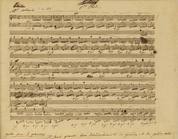



A - Autograph
| Date: | X 1836 – VI 1837 |
| Title: | Etudes || 1re Etude |
| Dedication: | Mme la Csse d'Agoult |
A constitutes the first element of a set of 12 manuscripts, including the entire Op. 25, dedicated for base text to GE1. Estimated time frame of creation of A can be determined in the following way:
- it includes a text of the Etude closer to the eventual version than the one of AI; hence it must have been created later, i.e. most probably after September 1836.
- 28 II 1837 Chopin confirmed in writing the transfer of rights to the aforementioned collection of 12 manuscripts to the German editor, Breitkopf & Härtel, including A. The manuscripts themselves were definitely not ready at that moment (see below), yet the autographs could have been already written (without the last retouch), due to the need of double copying.
- 9 VII 1837 Heinrich Albert Probst, intermediary between Chopin and his German editor, sent the manuscripts of the Etudes to Leipzig. Chopin was most probably refining his works until that very moment, introducing last corrections into his manuscripts.
When writing A, Chopin most probably had in front of him a working (sketchy? – [As]) notation of the piece, most probably the same on the basis of which AI was created. It is proved by a number of compatible corrections in both autographs, e.g., the hamonic change at the beginning of bar 23 or the change of the 14th and 15th semiquaver in the R.H. in bar 27. If – which seems to be highly likely – at the time of works on A Chopin already did not have access to AI, also the visible in A corrections from the versions written in AI prove their common provenance.
A was probably the only Stichvorlage autograph, which is proved by the common mistake of A, FE and EE in bar 20. Chopin's writing reveals quite a haste – the manuscript is plenty of characteristic "hooks" which emerge when the writing person moves the hand before detaching the quill from the paper.
A includes a lot of – as for a manuscript dedicated for base text to editions – deletions, corrections and additions. A part of them was probably performed on the go, at the time of writing, as all the sources coming from A – CDP, copies being base texts to FE and EE (lost) and GE – include the already corrected version (e.g., change of the part of the R.H. in the 2nd half of bar 20). The other must have been introduced some time after having written the whole, as they were not included in CDP (e.g., changes in the part of the R.H. in bars 22-23). Finally, there are some, most probably introduced directly before sending A to Leipzig, which were considered only in GE (e.g., deleting the last note in the L.H. in bar 16).
The slurring of A is generally legible. Some doubts arise only in the places where Chopin ends the slur on the melodic note or slightly after it, so that a few small notes of harmonic figuration remains out of the slur. Such situations appear from the beginning of the Etude, e.g., in bars 2, 3, 6, 10. Comparison of similar places, as well as a few other arguments, lead to the conclusion that these are inaccuracies of notation:
- in spite of the shorter slur in bar 3, the sign in bar 4 clearly suggests continuation, which finds confirmation in the undeniable slurring of analogous bars 11-12;
- in bar 12 Chopin extended the previously written shorter slur to the end of the bar;
- the shorter slurs in bars 30-31 are corresponded with the slurs in bars 26-27, clearly reaching the end of the bar.
We discuss this issue in detailed notes only in more problematic situations, e.g., in bars 36, 38 and 40.
At the bottom of the first page, there is the following "note for the engraver – it is necessary to clearly differentiate in print big and small notes." (The French original: "Nota pour le graveur. Il faut graver bien distinctement les grandes et les petites notes.") It cannot be excluded that Chopin's caution in this respect originated from the edition, which took place just two years earlier, of the Mazurka in C major, Op. 24 No. 2, bars 70-88, where this difference was not included.
| Original in: | Biblioteka Narodowa, Warsaw |
| Shelf-mark: | Mus 217 |

